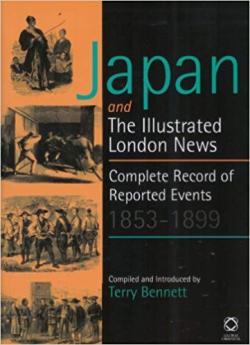Japan and the Illustrated London News: Complete record of Reported Events 1853-1899

Global Oriental, 2006, 411 pages including index, fully illustrated, £125, ISBN 1-901903-26-5,
Review by Sir Hugh Cortazzi
The Illustrated London News was among the first journals to carry illustrations of contemporary events. The journal, which started in 1842 before the advent of photography, had to rely until 1887 on engravings printed from woodblocks. The first article in the Illustrated London News relating to Japan appeared in May 1853. It was devoted to ‘The United states Expedition to Japan’ and included a portrait of Commodore Perry and an engraving of the US Navy’s steam Frigate Mississippi. In 1855 Admiral Stirling’s visit to Nagasaki was covered in some detail and sketches of Nagasaki were reproduced.
The most interesting reports in the journal were those contributed in the years between 1861 and 1887 by the artist Charles Wirgman (1832-1891) who founded and edited the Japan Punch, a satirical record of life in the foreign settlement. He was a talented artist who had the ability to draw quickly. He had an engaging personality and became a close friend of Ernest Satow, who was then a young Japanese language student, but who became the leading Japan expert of his era and British Minister to Japan from 1895-1900.
One of Wirgman’s earliest reports was an account of the murderous attack on the British Legation then housed in the temple of Tozenji at Shinagawa which was in those days not far from the water’s edge. With this report, among other illustrations of the affair, he included a sketch showing Japanese ronin attacking two British members of the legation
There were some unfortunate gaps in Wirgman’s reporting. There is, for instance, no account of the infamous Namamugi incident in 1863 when Richardson, a British merchant from Shanghai, was murdered while riding on the Tokaido. This led in due course to the British expedition against Satsuma and the bombardment of Kagoshima. Wirgman, however, managed to join this expedition and gave an account of the action. He also accompanied the forces which destroyed the batteries in the straits of Shimonoseki in 1864 and thus reopened the straits to foreign shipping. His graphic illustrations of these events are fascinating.
Wirgman later cooperated with the pioneer photographer Felix Beato, turning landscape photos of Yokohama and Tokyo into engravings which could be reproduced in double spreads in the magazine. The development of sepia photography in the 1880s revolutionized the way in which the journal covered events. The Sino-Japanese war of 1894-5 was reported and illustrated in some detail and the ILN had something of a scoop.
The production of this book clearly involved a great deal of work not least in extracting the references to Japan. The original text was handset in small type and was hard to read. In this edition typesetting errors have been corrected and larger type used. The book of items relating to Japan which was published in 1973 with translations of articles into Japanese was incomplete and inadequate; a new full edition of the original articles and illustrations was needed.
Students of the history of Japan and in particular of Japan’s relations with foreign countries in the second half of the nineteenth century will find this book invaluable. It contains contemporary eye-witness accounts of events and profiles of important individuals together with illustrations which show much better than descriptive prose what the life was like at that time. The source material in this book is in many ways unique. At first there were no Japanese language newspapers, and English language papers published in Yokohama generally did not carry illustrations. Anyone, however, looking for a contemporary analysis of the course of events or explanation of the background to for instance the Meiji Restoration and the movement for a constitution will be disappointed. Perhaps it is unreasonable to hope for this from a popular illustrated journal.
The publishers are to be congratulated on reproducing this unique resource for historians, but this is not just a book for specialists. It can be read with pleasure and interest by anyone who wants to know what Japan was like in the latter part of the 19th century. Let us hope that this book will be a forerunner for a further volume covering the Russo-Japanese war and later events.

